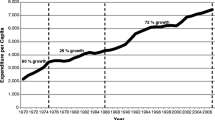Abstract
This paper is a descriptive analysis of the basic demographic characteristics that determine the size and distribution of the American Indian population. The data reported are obtained from the 1990 Census, the National Center for Health Statistics, and the Indian Health Service. Among the findings reported in this paper is that American Indians have higher levels of fertility than other groups, especially whites. Mortality due to accidents, diabetes, and alcohol-related illness is especially high for American Indians. And despite relatively high levels of residential mobility, the distribution of the American Indian population has been relatively stable since 1970.
Similar content being viewed by others
References
Aberle, S.B.D. (1931). Frequency of pregnancies and birth interval among Pueblo Indians, American Journal of Physical Anthropology 16: 63–80.
Aberle, S.D., Watkins, J.H. & Pitney E.H. (1940). The vital history of the San Juan Pueblo, Human Biology 12: 141–187.
Bachman, R. (1992). Death and violence on the Reservation. Westport, CT: Auburn House.
Bernstein, A.R. (1991). American Indians and World War II: Toward a new era in Indian affairs. Norman, OK: University of Oklahoma Press.
Blumenfield, R. (1965). Mohawks: Round trip to the high steel, Transaction 3: 19–22.
Campbell, G.R. (1991). Changing patterns of health and effective fertility among the Northern Cheyenne of Montana, 1886–1903, American Indian Quarterly 15: 339–358.
Clinton, L., Chadwick, B.A. & Bahr, H.M. (1975). Urban relocation reconsidered: Antecedents of employment among Indian Males, Rural Sociology 40: 112–133.
Eschbach, K., Supple, K. & Snipp, C.M. (1995). Changes in racial self-identification and changes in the educational attainments of American Indians, 1970–1990. Paper presented at the annual meeting of the Population Association of America, San Francisco, CA.
Fixico, D.L. (1986). Termination and relocation: Federal Indian policy, 1945–1960. Norman, OK: University of Oklahoma Press.
Gundlach, J.H. & Roberts, A.E. (1978). Native American Indian migration and relocation: Success or failure, Pacific Sociological Review 12: 117–128.
Hackenberg, R.A. & Wilson, C.R. (1972). Reluctant emigrants: The role ofmigration in Papago Indian adaptation, Human Organization 31: 171–186.
Hagan, W.T. (1979). American Indians. Chicago, IL: University of Chicago Press. 92 C. MATTHEW SNIPP
Hahn, R.A. (1992). The state of federal statistics on racial and ethnic groups, Journal of the American Medical Association 267: 268–271.
Hahn, R.A., Mulinara, J. & Teutsch, S.M. (1992). Inconsistencies in coding of race and ethnicity between birth and death in US infants, Journal of the American Medical Association 267: 259–263.
Hambright, T.Z. (1968). Comparability of age on the death certificate and matching Census record. National Center for Health Statistics. Series 2, No. 29. Washington, DC: US Government Printing Office.
Harris, D. (1994). The 1990 Census count of American Indians: What do the numbers really mean?, Social Science Quarterly 75: 580–593.
Indian Health Service (1993). Trends in Indian health. Washington, DC: US Department of Health and Human Services.
Indian Health Service (1994). Trends in Indian health. Washington, DC: US Department of Health and Human Services.
Institute for Government Research (1928). The Problem of Indian administration [The Meriam Report]. Baltimore, MD: Johns Hopkins University Press.
Kunitz, S.J. (1976). Fertility, mortality, and social organization, Human Biology 48: 361–377.
Merrell, J. (1989). The Indian's new world: The Catawba and their neighbors from European contact through the period of removal. Chapel Hill, NC: University of North Carolina Press.
NCHS, National Center for Health Statistics (1995). Health, United States, 1994. Hyattsville, MD: Public Health Service.
O'Brien, S. (1989). American Indian Tribal Governments. Norman, OK: University of Oklahoma Press.
Omran, A.R. (1971). The epidemiological transition: A theory of the epidemiology of population change, Milbank Memorial Fund Quarterly 49: 509–538.
Passel, J.S. (1976). Provisional evaluation of the 1970 Census count of American Indians. Demography 13: 397–409.
Passel, J.S. & Berman, P.A. (1986). Quality of 1980 Census data for American Indians, Social Biology 33: 163–182.
Price, J.A. (1968). The migration and adaptation of American Indians to Los Angeles, Human Organization 27: 168–175.
Rindfuss, R.R. & Sweet, J.A. (1977). Postwar fertility trends and differentials in the United States. New York: Academic Press.
Rogers R.G. & Hackenberg, R. (1987). Extending epidemiologic transition theory: A new stage, Social Biology 34: 234–243.
Snipp, C.M. (1989). American Indians: The first of this land. New York: Russell Sage Foundation.
Snipp, C.M. & Sandefur, G.D. (1988). Earnings of American Indians and Alaska Natives: The effects of residence and migration, Social Forces 66: 994–1008.
Sorkin, A.L. (1971). American Indians and federal aid.Washington, DC: Brookings Institution.
Sorkin, A.L. (1978). The urban American Indian. Lexington, MA: D.C. Heath.
Sorkin, A.L. (1988). Health and economic development on American Indian reservations, pp. 145–165, in C.M. Snipp (ed.), Public policy impacts on American Indian economic development. Albuquerque, NM: Institute for Native American Development, University of New Mexico.
Taffel, S.M. (1987). Characteristics of American Indian and Alaska Native births: United States. NCHS Monthly Vital Statistics Report, Vol. 36, No. 3. Hyattsville, MD: National Center for Health Statistics.
Thornton, R. (1987). American Indian holocaust and survival. Norman, OK: University of Oklahoma Press.
Thornton, R., Sandefur, G.D. & Snipp, C.M. (1991). American Indian fertility patterns: 1910 and 1940 to 1980: A research note, American Indian Quarterly 15: 359–367.
US Bureau of the Census (1915). Indian Population in the United States and Alaska, 1910. Washington, DC: US Government Printing Office.
US Bureau of the Census (1992). General Population Characteristics, United States, 1990. Washington, DC: US Government Printing Office.
US Bureau of the Census (1993). Social and Economic Characteristics, United States, 1990. Washington, DC: US Government Printing Office.
Weibel-Orlando, J. (1991). Indian Country, L.A. Urbana, IL: University of Illinois Press.
Wissler, C. (1936). Changes in population profiles among the Northern Plains Indians, Anthropological Papers of the American Museum of Natural History 36: 1: 1–7.
Young, T.K. (1994). The health of Native Americans. New York: Oxford University Press.
Author information
Authors and Affiliations
Rights and permissions
About this article
Cite this article
SNIPP, C.M. The size and distribution of the American Indian population: Fertility, mortality, migration, and residence. Population Research and Policy Review 16, 61–93 (1997). https://doi.org/10.1023/A:1005784813513
Issue Date:
DOI: https://doi.org/10.1023/A:1005784813513




